Yes, You Can Freeze Salad Dressing. Here's How To Do It The Right Way
Although it seems like they may last forever, salad dressings do have an expiration date and eventually go bad even in the fridge. According to the USDA, salad dressing can last up to two months refrigerated before it needs to be thrown out. However, like many foods, you can extend the shelf life of salad dressing by tossing it in the freezer.
While it may not taste as fresh as a new bottle from the store, most salad dressings can be frozen with some exceptions. However, you would be making a mistake with your dressing if you just put that plastic squeeze bottle straight into the freezer. Instead, you should transfer the contents into an air-tight container making sure to create a tight seal with the lid. There shouldn't be any air bubbles in the mixture as they can prove disastrous during the freezing process. Air bubbles can cause freezer burn, which causes the outer layers of food to lose moisture, and can ruin the salad dressing.
You should also check the best-used-by date before freezing. Keep in mind that freezing food suspends it in the state it's already in so it can't save dressing that's going bad. When done properly, your frozen salad dressing will last up to three months in the freezer. However, just as anything, there are some exceptions to the rule to keep in mind.
Exceptions to freezing salad dressing
When it comes to freezing salad dressing, generally vinegarettes work best. Vinegarettes are a fusion of vinegar and oil and will freeze well because they're temporary emulsions. Temporary emulsions are two ingredients that temporarily join together before separating. However, there are two types of salad dressing that you should probably reconsider freezing. You shouldn't freeze a salad dressing if it has a permanent emulsion. Think mayonnaise-based salad dressings. Mayonaisse is a combo of oil and egg yolks with vinegar, permanently fused. However, when you freeze a permanent emulsion, its ingredients separate during the freezing process which ruins the salad dressing.
Likewise, you should probably reconsider freezing dairy-based salad dressings. Dairy-based dressings are known for their creamy texture, which likely isn't the same after the freezing process. However, you can attempt to rescue the salad dressing by thawing it to a semi-thawed state and then vigorously whipping the mixture to try to give it some volume. Alternatively, you can also use frozen dairy-based dressings that have lost their consistency for cooking rather than for salads as a way of repurposing the condiment. It's also best to temper one's expectations. Thawed salad dressings may not taste exactly like they would have prior to freezing because some ingredients may have altered.
Can you freeze salads?
You have your frozen salad dressing ready for when you need it. You're probably wondering if you can toss your salad greens in the freezer as well to eat at your leisure. While salads are delicious, they can also be a bit of a pain since they have such a short shelf life. According to the USDA, salads last three to five days in the fridge. Unfortunately, it wouldn't be a smart idea to throw your salad mix into the freezer.
Salads contain several ingredients that lose their quality upon freezing. In particular, greens like spinach and lettuce become slimy when frozen, making for a poor salad. You won't get that crisp lettuce that every good salad calls for. The issue is that lettuce and salad greens don't freeze well. They contain too much water. When you freeze lettuce, it causes ice crystals to form and destroy the vegetable on a cellular level.
Some lettuces can be frozen. Think Romaine or Boston lettuce variants for instance. However, you still wouldn't toss them in a salad when thawed because the vegetables will be mushy. Instead, they could be cooked in a recipe, just not a salad. Likewise, other vegetables like tomatoes also don't freeze well.


